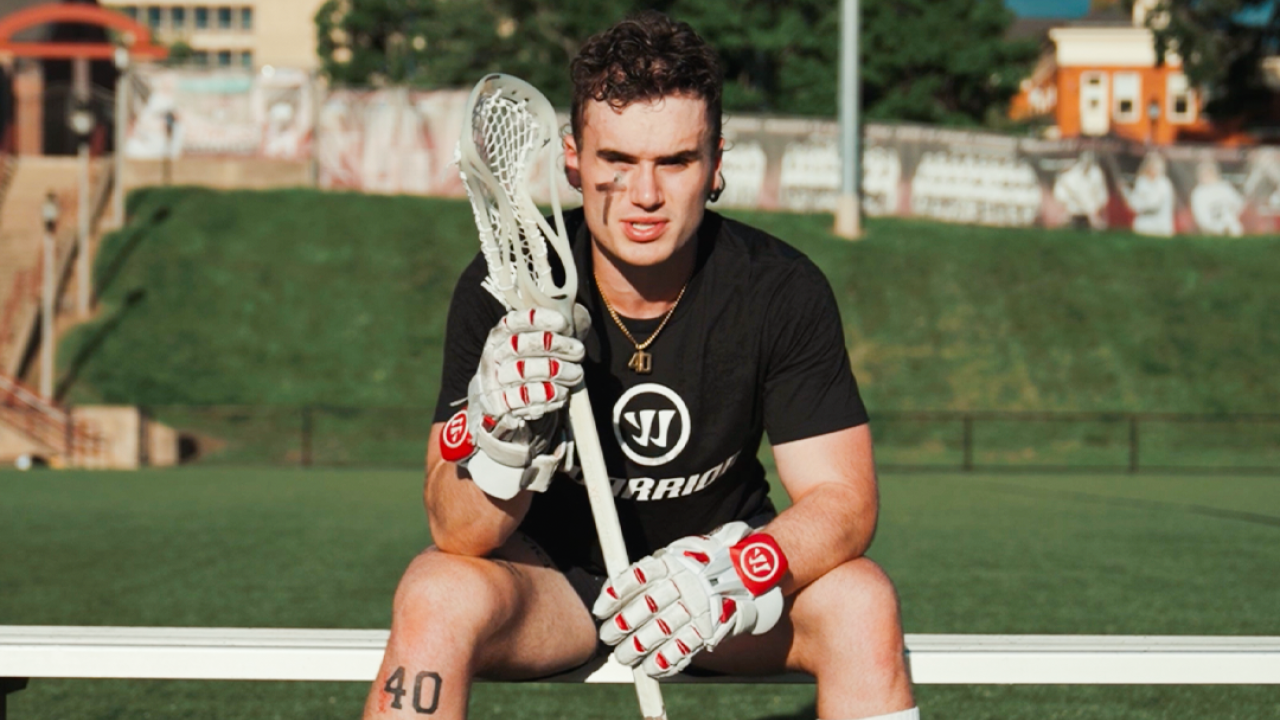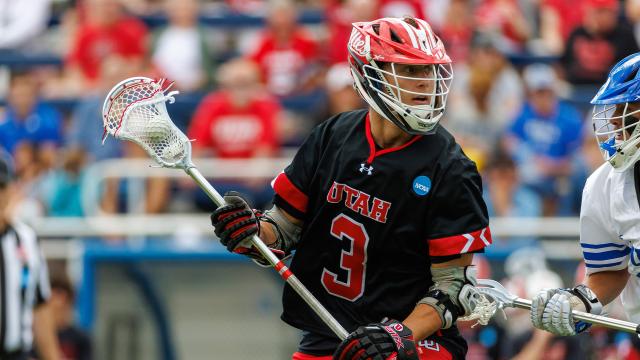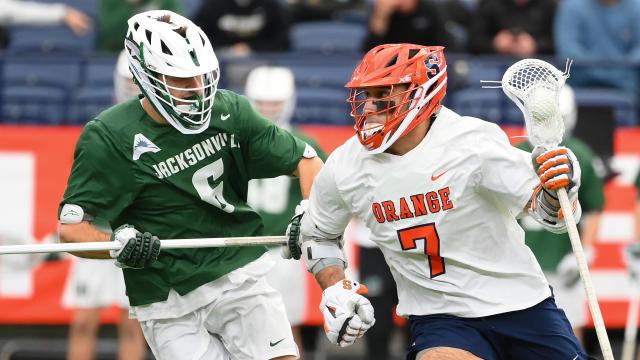
How Caleb Hammett Became 'The Drip King'
Caleb Hammett approaches the faceoff stripe. He bends, positioning himself for another draw. Most of the crowd at UMass is there to see him. They scream his name — both given and fictional.
The Hanover, Mass., native isn’t your ordinary lacrosse player. He’s made a name for himself in two places — on the field, where he was a member of the All-CAA first team in 2022, and off the field, where he’s become one of the largest social media influencers in the sport.
Hammett — aka “The Drip King” — recently eclipsed 2 million followers on TikTok. He has just north of 370,000 followers on Instagram and 310,000 subscribers on YouTube. To those who aren’t necessarily lacrosse super fans, Hammett might just be the face of the sport.
That attracts equal parts fandom and ire. UMass head coach Greg Cannella said Hammett draws a crowd at every game, home or away.
It harkens back to the days when “Garber’s Gorillas” patrolled the field that now sports Hall of Fame head coach Dick Garber’s name. Garber’s players were gritty. Punch them, and they’ll punch back (and not always figuratively). “ZooMass” was once a lacrosse hotspot for fans — both for the team’s success and for the brand of lacrosse it played.
Now, decades later, there’s increased attention on UMass again. This time, for a very different reason.
“We have sort of this cult-ish following of kids at every game,” said Cannella, who played for Garber and is entering his 30th year as UMass’ head coach.
The chagrin, or perhaps resentment or jealousy, comes from opponents. Especially other faceoff men. The faceoff is a war. Two chiseled athletes go head-to-head in what’s essentially a full-body arm wrestling match for possession. It’s a full-out effort for 5, maybe 10, seconds. And these athletes do it 15-20 times per game.
Hammett is so quick with his hands and feet that when he gets momentum, he can completely tilt the field. He has a stable of defensive counters he can use to at least slow the opposition from winning possession cleanly. He’s also incredibly fit and strong, evidenced by the time he spends in the weight room with sports performance coach Antwan Harris.
So, any advantage helps.
“Sometimes, before he even takes a faceoff, the opposing team is coming after him,” Cannella said. “The other teams are jealous of his popularity and what he’s doing and the income he’s made.”
None of it bothers Hammett. Cannella thinks he’s matured past the point of it affecting his performance.
“Unless it’s my family or someone close to me, I honestly don’t care [about the chirping],” Hammett said. “I’m numb to that. … I take it as a compliment, the amount of people who know who I am. I don’t know who you are.”
If that sounds smug, Hammett doesn’t mean it that way. He is still getting used to this whole “social media star” thing. At the beginning of the 2023 season, Hammett had fewer than 100,000 TikTok followers. It took him only six months to reach 2 million.
In half a year, Hammett’s life has completely changed. He’s not the man people think he is after watching one of his many viral videos. He’s reserved. A loner. A family man. Most of all, he’s just trying to find happiness.
FIRST THINGS FIRST: LET’S DEFINE TWO KEY WORDS IN THE DRIP KING LEXICON — “drip” and “rizz.”
“Drip” is having style and looking good on the field. It’s the eye black and the shorter shorts and the helmet tilt. Maybe a leg sleeve for good measure.
That’s how The Drip King was born. At the beginning of last summer, Hammett began making “Drip or Skip” videos in which he rated someone’s drip on a scale of 1-10. It grew in popularity and first put him on the map.
Hammett is the adjudicator of drip. The curls that protrude from the back of his helmet. The signature eye black crosses that create intimidating shadows under his facemask. The tattoos on his right thigh only visible because his shorts could draw comparisons to the three-inch inseam of 1950s basketball players.
His appearance certainly draws attention.
“Rizz” is having charisma around women. It’s how the kids talk on social media, and Hammett is a key stakeholder in middle school slang.
There are layers to Hammett’s schtick. Much of his rise can be attributed to his connection to LSU gymnast Livvy Dunne, the most popular NCAA athlete in the world. Hammett’s attempts to court Dunne, who’s earned the mantle of “Drip Queen” from Hammett’s followers, have helped him reach virality.
While Hammett’s TikTok following is nothing to shake a stick at, it pales in comparison to the 7.7 million people who’ve followed Dunne.
So, when the two collaborated on a live TikTok in late January, his popularity boomed —perhaps even at a rate Hammett himself didn’t expect.
“I don’t necessarily find myself funny,” Hammett said. “But people around me do. I use that to my advantage.”
He tries to be “a breath of fresh air” in a stressful sports environment. Part of that is embracing his relationship with his faith. Hammett is vocal about God on his platform and thinks it wouldn’t be authentic to hide something from his audience that is such a pivotal part of his life.
It wasn’t always that way. Hammett grew up Catholic but described it was “lukewarm.” He and his family would attend church every once in awhile, but it was hardly part of his personality.
That changed last summer. Right when he began his social media journey, Hammett endured a breakup that was difficult to process. A few of his close friends at UMass were close with their faith and invited him to bible study. It helped him grow “tremendously.”
“It’s easy to talk about lacrosse, but when you really speak deeply with someone about what’s going with their life, you definitely get a deeper connection,” Hammett said.
Hammett’s faith has helped him embrace (and chase) two other lessons he tries to impart to his audience — humility and peace off the field.
“Followers, money, stuff like that, it’s all rewarding,” he said. “But it doesn’t buy happiness and shouldn’t change you as a person.”
LONG BEFORE THE DRIP KING WAS THE DRIP KING, Hammett wanted to make eye black.
He started wearing eye black when he was younger, for no other reason than he liked it. He didn’t wear much eye black as a freshman at college because he wanted to prove himself on the field before he drew too much attention to himself. Go figure.
So, the budding entrepreneur now enabled to pursue his passions by NIL language set out to make his dreams come true.
“I had calls with companies back then,” Hammett said. “To be quite frank, I was told the only way it would work is if I did white labeling with them. That motivated me even more to do it on my own.”
“White label” products are sold by retailers with their own branding and logo, but the products themselves are manufactured by a third party. For example: with stainless steel water bottles in high demand, an entrepreneur could find a white label partner who sends them generic stainless steel bottles for them to then affix their brand logo on.
That wasn’t going to work for Hammett. He wanted something entirely his.
Hammett drained every dollar from his bank account, one that had yet to see an influx of cash from his soon-to-be social media rise, to make the DripStick. He found a manufacturer overseas, made samples and perfected it.
“This company is 100-percent me,” he said. “There’s nothing else behind it.”
The Dripstick is a petroleum- and paraben-free eye black that “reduces glare and helps keep you focused on the field, on the court, in the classroom, on the links and even in the grocery store.”
“Beware of the imminent drip,” Hammett wrote in the testimonial section of www.dripstick.shop.
Hammett produced 1,800 sticks, sold in three packs along with “Drip Off Wipes” to remove after use. He sold the set for $36 and said the pack of three sticks should last a full season — even if he goes through a stick per week himself.
In February, his stock sold out in less than a day.
Hammett used his platform to market his product — a synergistic approach pushed often by Colin Rosenblum and Samir Chaudry, the creators of “The Lacrosse Network” who now operate as a resource for content creators on YouTube and beyond.
“Eye black is eye black, but the DripStick is its own thing,” Hammett said. “It’s a community.”
Because the company is all him, Hammett fulfilled all the orders himself. He packed them, shipped them and even included a handwritten note with every order.
“Every penny came from my bank account,” he said. “I was just a broke college student when I did it.”
Hammett’s “Drip King” moniker has helped him earn lucrative partnerships with Warrior and Lax.com. Not to mention the countless appearances he makes at camps that often distract attendees from the reason they’re at these camps in the first place.
It’s Beatlemania in 2023, only the medium is a smartphone, and the subject is a person who, off camera, would prefer to be far away from the spotlight.
MITCHELL PEHLKE KNOWS A THING OR TWO ABOUT BEING A CONTENT CREATOR.
The Ohio State graduate, who owns and operates the YouTube channel bearing his name, has posted 600-plus videos on the platform and has more than 62,000 subscribers who come to him for longform content.
Pehlke knows what it’s like to live two lives, one on camera and one behind it. After meeting up with Hammett to do a collaboration last summer, he learned surprising things about his contemporary.
“He’s a little more reserved,” Pehlke said. “When you play a character on social media, you’re that character when you meet fans on the street. And that’s the hard part of playing the character. When Drip King is offline, he’s just Caleb.”

Hammett was surrounded by social media long before The Drip King. His mother, Andrea, runs an interior design account on Instagram that boasts more than 120,000 followers. His sister, Abby, runs a fitness account that’s popular on both TikTok and Instagram.
In some ways, social media is in his blood. Lacrosse wasn’t always as front and center.
Growing up in Hanover, Mass., Hammett played just about every sport. Lacrosse was his No. 3 behind hockey and football. Going into sixth grade, he realized he could have a potential future in lacrosse, so he focused more on his craft.
He played for the lowest club team on Laxachusetts as an attackman and played one year before getting cut. He contacted Joe Nardella, then an assistant at nearby Harvard, who started teaching Hammett how to face off in eighth grade.
“Caleb is one of those kids who will do every single thing that you ask of him,” Nardella said.
Hammett went on to make Laxachusetts’ top team as a FOGO. It took him just three tournaments before he got an offer from Army in December of his freshman year at Hanover High School. The high of getting his first offer was overshadowed by ups and downs the following three seasons.
As a freshman, Hammett missed six months — including the summer club circuit — due to a partially torn tendon in his right wrist. As a sophomore, playing midfield and facing off, shin splints and a stress fracture forced him to miss most of the spring. He nearly made it through his entire junior season unscathed before a groin injury in his final playoff game held him out of another summer club circuit.
Contemplating his future, Hammett decommitted from West Point.
“When I was a freshman, I was very young,” Hammett said. “West Point’s one of the most prestigious schools. I loved the coaching staff there. When I became a junior, I had cold feet about serving. When you go there, you have to be 100-percent bought in. I think it was a blessing in disguise.”
Nardella was close with then-UMass assistant Craig McDonald, who is now the head coach at Robert Morris. He put McDonald and Hammett in touch with each other, and Hammett committed to stay close to home. Rejuvenated, Hammett was dialed in and named a captain for his senior season.
COVID-19 took it away before it could even start.
Hammett used the time off to prepare himself physically for UMass. He said he transformed himself and also used the down time to practice the standing neutral grip, which had just been adopted by the NCAA.
Two days before the first game of his freshman season, he took a slash in practice and broke his thumb. He tried to play through it but ultimately took 21 faceoffs over three games before shutting it down and redshirting.
The injury bug hasn’t bitten Hammett since, at least not in a major way. He went 185-for-301 (61.5 percent) as a redshirt freshman in 2022, making the All-CAA first team. He finished fifth in the nation in faceoff percentage. He then played in every game of 2023, winning 56.5 percent of his draws and earning a spot on the inaugural Atlantic 10 second team.
“He’s very resilient,” Nardella said. “Not everyone pans out taking a couple hundred reps in practice every week and then playing 15-20 games against grown men. I knew he’d be good.”
It helps to have substance behind the kind of attention that Hammett draws.
“When you’re doing well, it doesn’t bother you,” Nardella said. “When you’re doing poorly, it compounds. I give him a lot of credit for putting together [56.5 percent] despite it all.”
Hammett doesn’t think of himself as any different than the person who built a brand without a dollar in his pocket. When people tell him he’s famous, he says, “No, I’m not.”
The past year has been a whirlwind, and he thinks he’s grown as a man and become a better person through it all. He’s just trying to stay centered in the moment because he knows The Drip King can’t be around forever.
That’s why the chirps don’t bother Hammett all that much. It’s part of the deal. He’ll always be that in-state kid with a little bit of a chip on his shoulder, bringing fans back to Garber Field like it’s the 1970s.
“If I was on the other end of it, I’d probably try to chirp myself as much as I could,” he joked.
But if you come at the king, you best not miss. He’s got 2 million strong ready to come to his defense.
Kenny DeJohn
Kenny DeJohn has been the Digital Content Editor at USA Lacrosse since 2019. First introduced to lacrosse in 2016 as a Newsday Sports reporter on Long Island (yes, ON Long Island), DeJohn specializes in women's game coverage. His search for New York quality pizza in Baltimore is ongoing.

Related Articles




